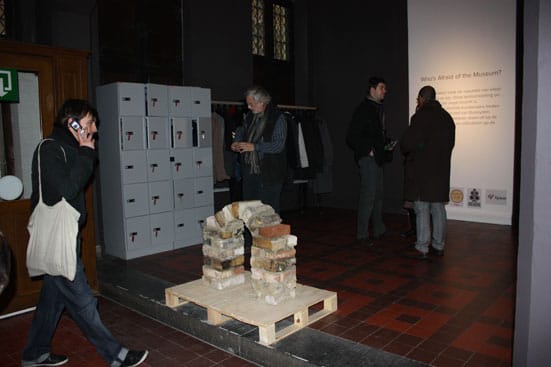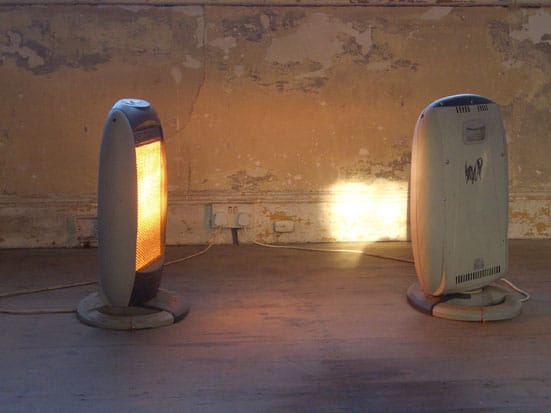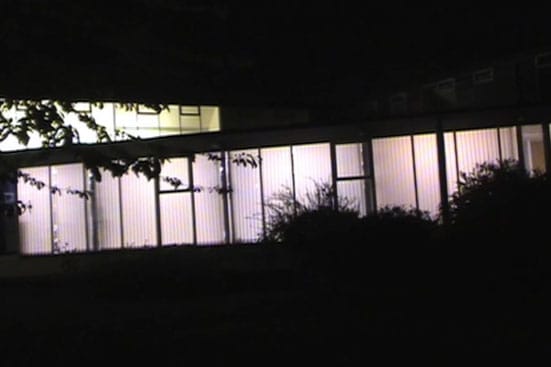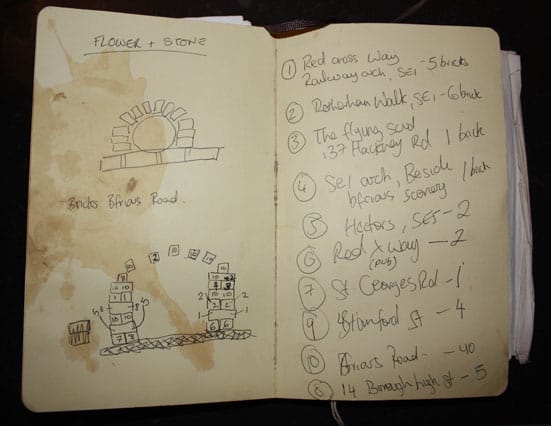For her show at Siobhan Davies Studios Laura Wilson responded to the building and its history through a body of work that included installation, video, drawings, photography and two live performance pieces.
Wilson met with Sarah Wigglesworth, architect of the building and worked directly in response to the original architectural plans of the studios to produce Drawing on Large Glass, a site-specific drawing with PVC tape. Quite a Stranger Aren't You, a duet of identical rotating heaters moving in unison, appear to dance with each other at the foot of the stairwell, here Wilson has brought her distinctive idiosyncratic language to play. Her personification of ostensibly inanimate objects sit cheek by jowl to this vibrant dance environment creating a subtle play between artificial and human kinetics unified within Wigglesworth's open space. Window blinds were opened and closed in a carefully choreographed performance of Blind Building on the London College of Communication 13 storey tower block during the opening of the exhibition. A film of Blind Building is also presented in this exhibition, accompanied by a soundtrack by musician Eleanor Wynne Davies. A photograph of a blood red moon, a video of the light pouring through a skylight over the course of an evening, changing light patterns and choreography run through the exhibition and keep it in constant flux.
The exhibition runs until 7 March 2010 at Siobhan Davies Studios.
FB: You have been in several group shows, so here for your first solo show, what did you enjoy the most in making it?
LW: When I was thinking about what work I would show at Siobhan Davies, I treated the building in the same way that I would when working with something in my studio: I experimented with it and played with it until I found a solution. I enjoyed deciding how my work fitted within the existing building and reacted to it. Also, Siobhan Davies Studios is a unique place to install an exhibition, as the building is constantly inhabited by a flurry of different people, dancers and choreographers stretching on the floor while I was up and down a genie lift/ cherry picker installing a piece of work. It was interesting talking to these people and exchanging ideas.
FB: What's the relationship between your performance work and your installation work?
LW: My practice is primarily rooted in sculpture. I recognise, however, that sculpture isn't necessarily the best method to communicate all my ideas, therefore I look to other means such as performance, film, installation or drawings to explore them; so the chosen medium is dependent on the set of circumstances that the work requires. I tend to work on a lot of different ideas or pieces simultaneously, which sometimes leads to them feeding off and fusing with each other, and sparking off ideas for a new piece of work. However, often one work in one medium bears little connection to the work made in another.
FB: Some of your work has required people to be actively doing something to make the work happen –stepping on a spring board, sending postcards back to the mail box … How much room do you allow for chance in your work?
LW: I am really interested in how the viewer can interact with my work, through an actual physical interaction, which can result in the completion of the piece. For example, Phaser requires a curious viewer standing on or moving the plywood board. This physical interaction produces a resonance within a slinky which is transmitted though the medium of the polystyrene. A louder version of the slinky is presented to the audience, of which the sound intensity, rhythm and pitch is controlled by the participant. In this work, the body acts as sculptural force, both in the production process of the work and in the final product. I tend to set up parameters, or a certain set of rules that either I or the viewer must follow, which results in certain aspects being left to chance. So for example, with Postbox, postcards delivered to various locations invited an uncontrolled or random public performance response to the work. These random acts then fell under the control of the postal system. Once the postcards were delivered to my post box standing outside the (then derelict) 67 Peckham Road the work returned to the realm of the uncontrolled and random.
FB: Some work you perform, some you get others to do it, why? What place does this have in your practice?
LW: Again, I think it depends on the work. Take, for example, the two performances that took place during the exhibition at Siobhan Davies Studios. With Blind Building I had the option to motorise the curtains on the windows, but I am interested in human error, and wanted the building to be played almost like an instrument. So I wrote the score, which was read out by a conductor to ten performers inside the building, each in control of a curtain. For Flaming Fusee, only one performer was needed, and it didn't make sense for it to be anyone else but me.
FB: What do you currently collect?
LW: I have been collecting postcards for years, both ones that people send me or that I collect when I visit different places. Also, I have been collecting bricks for the last year, this started off as a piece of work for an exhibition in Mechelen, which is currently at the Museum Hof van Busleyden. The work Flower and Stone, is an arch entirely composed from bricks that I have collected from demolished buildings in London; after the exhibition in Mechelen I am going to demolish my structure and I am working with a developer to build the bricks into new buildings in Belgium. Although I'm not collecting bricks for this purpose anymore I can't help but keep collecting them.
FB: You have been awarded the Winston Churchill Memorial travel Fellowship for your brick project. What sort of ‘building project' are you cooking?
LW: I am going to spend the next year researching bricks. Over five weeks, I will travel to different countries in Europe (such as, Germany, Holland, Spain and Switzerland) and to China to carry out my research. I hope to make contact with architects, brick companies and master bricklayers whilst on my travels. Everything will be documented on my website, www.laurawilson.me and I plan to make new work as a result of the research too.
FB: How do you think our every day environment impacts or reflects what we are? And what does it tell about us according to you?
LW: I think your environment plays a part of who you are, what you do and what decisions you make. My practice is informed by the everyday, my personal surroundings − the work I am making right now is a reaction to living in London and my experiences in it.
I notice how my work changes depending on my surroundings, for example when I was doing a residency at the Banff Centre (Canada) in 2008, the work I was producing there, and just after, was very much made as a result of living in sub-zero temperatures surrounded by snow.
FB: What do you like about your everyday?
LW: The sounds of London constantly fascinate me: the fact that there is so much noise and then suddenly you can turn off a street or be in the middle of the bridge and it is almost silent. Also, I enjoy the pace of the everyday, walking to work and seeing the same people walking in the opposite direction to me and being able to judge if I'm late or not. Also, when I see those people on a different street at a different time of day, that is quite an odd experience.
FB: What does your ‘blank canvas' look like?
LW: Chaos! I'm not sure that I have a 'blank canvas' as such, I am constantly working on something even if it doesn't turn out to be a piece of work. Also, I am a bit of a hoarder and find it quite difficult to through things away, just in case I need them for something, so my studio is filled with all these random collections of things, which makes it quite difficult to find a blank canvas, even conceptually speaking.
FB: What comes first: making the work or wanting to do it.
LW: Probably a mixture of both, my work is quite process-based, so a lot of it is made through failing and then trying again, but ultimately all I want to do is make it.
FB: Is making work a fun process?
LW: I love making work, but it can be frustrating and exhausting as it don't always end up the way I anticipated it to be, but I wouldn't want to be doing anything else.
Franck Bordese

Flower and Stone
2010
Laura Wilson

Quite a stranger aren't you
2008
Laura Wilson

Blind Building
2009
Laura Wilson
Still from DVD (6 minutes 58 seconds)

Study for Flower and Stone
2010
Laura Wilson